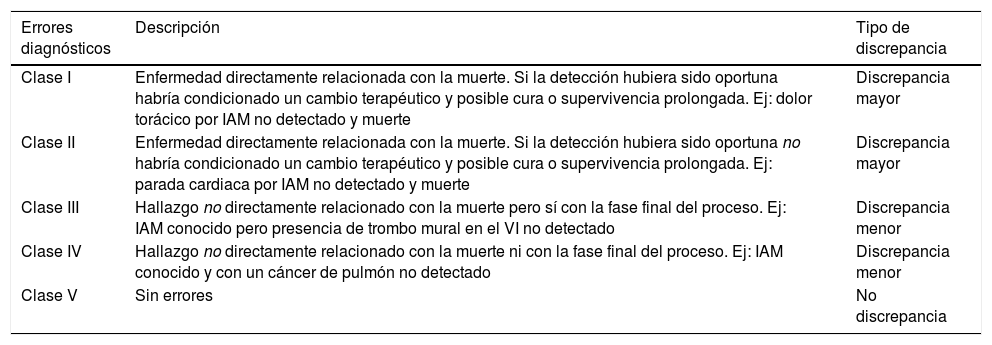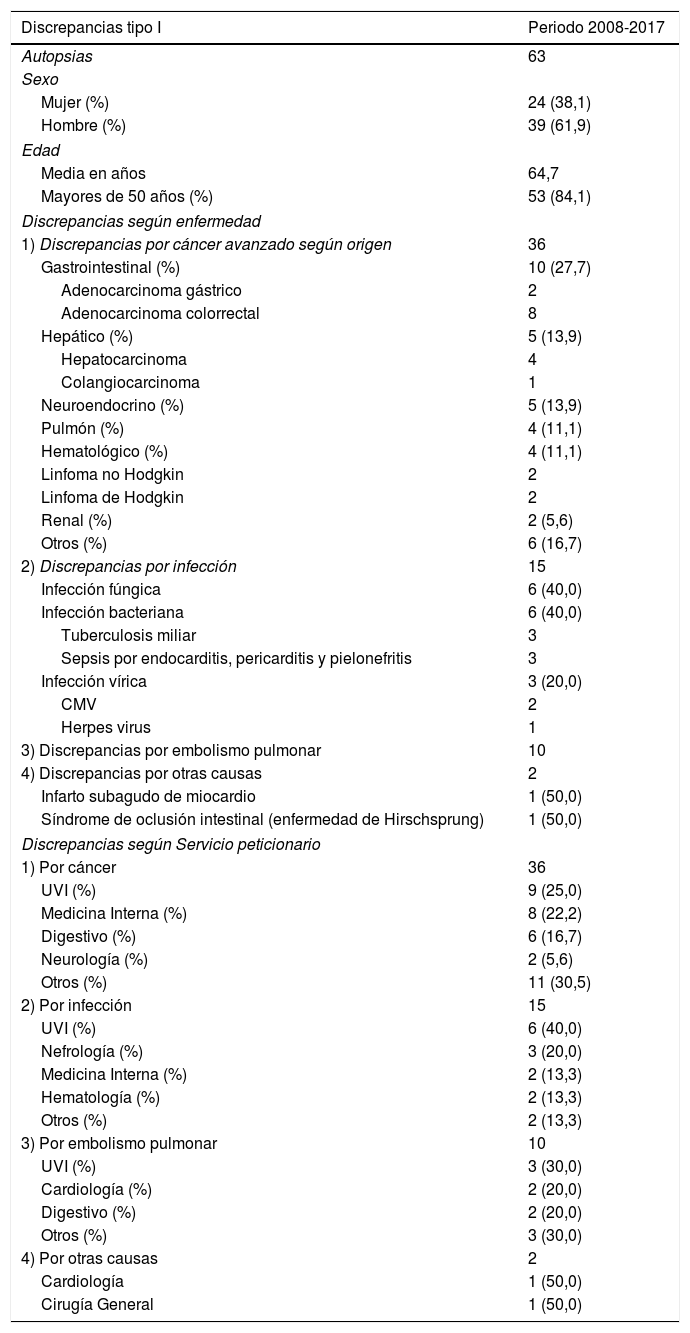Analizar el diagnóstico clínico ante mortem y el resultado de la autopsia clínica para identificar hallazgos inesperados de alta relevancia clínica.
Material y métodoEstudio retrospectivo observacional realizado en el Hospital Universitario Central de Asturias en el que se examinaron las autopsias de adulto y sus respectivas historias clínicas en la década 2008-2017 y se clasificaron siguiendo la Clasificación de Goldman y por servicios de procedencia.
ResultadosDe las 1320 autopsias se incluyeron finalmente 694 (52,6%). De ellas, hasta en un 57,6% se observaron discrepancias, la mayoría menores (39,3%). En 63 autopsias se identificaron discrepancias de tipo I (9,1%) siendo las neoplasias malignas la principal patología observada (57,1%), especialmente de origen gastrointestinal con cerca del 28% de los casos. Tras el cáncer, fueron las enfermedades infecciosas (23,8%) y después el embolismo pulmonar (15,9%). Por otra parte, 64 autopsias fueron clasificadas como discrepancias tipo II (9,2%) identificando mayoritariamente al infarto como principal causante (37,5%), sobre todo el infarto agudo de miocardio (18 casos), seguido de broncoaspiraciones (18,7%), CID (15,6%), hemorragias masivas (9,4%) y otros procesos. Se observó que tanto la UVI como el Servicio de Medicina Interna fueron los responsables del mayor número de discrepancias mayores (tipo I y II), representando cerca del 45% para discrepancias tipo I y algo más del 56% para discrepancias tipo II.
ConclusiónLas autopsias son una herramienta esencial de calidad hospitalaria para vislumbrar errores ante mortem significativos. El Hospital Universitario Central de Asturias muestra una proporción de discrepancias mayores (18,3%) en rangos similares a los mejores hospitales de referencia mundial.
To compare and contrast clinical diagnoses with autopsy findings in order to identify unexpected, relevant discrepancies.
Material and methodA retrospective observational study of the revision of autopsies of adults and their respective medical records in order to classify them according to referral department and Goldman's classification was carried out at the Central University Hospital of Asturias between 2008-2017.
Results694 (52.6%) of 1320 autopsies were included in the study. Discrepancies were observed in 57.6% of cases, although the majority (39.3%) were minor. Type I discrepancies were identified in 63 autopsies (9.1%); malignant neoplasms being the main pathology observed (57.1%), mainly of gastrointestinal origin (about 28%). The second most common discrepancy was found in cases of infectious diseases (23.8%) followed by pulmonary embolism (15.9%). 64 autopsies were classified as type II discrepancies (9.2%), with myocardial infarct the most common (37.5%), especially acute myocardial infarction (18 cases), followed by bronchoaspirations (18.7%), DIC (15.6%), massive haemorrhages (9.4%) and other conditions. It was considered that both the ICU and the Internal Medicine Service were responsible for the largest number of major discrepancies (type I and II), accounting for about 45% of type I and slightly more than 56% for type II.
ConclusionAutopsies are an essential means of identifying ante-mortem clinical errors. The incidence of major discrepancies in the Central University Hospital of Asturias (18.3%) is comparable to that of leading hospitals worldwide.
Artículo
Comprando el artículo el PDF del mismo podrá ser descargado
Precio 19,34 €
Comprar ahora













